|
APRIL 2022
|
|

New
York Times, June 9, 1979
|

|
|

|
|
***
|
Introduction
When writing these articles, I've had many occasions to pore over
Anne and Richard Evers' useful little book about
Hicksville
. The lead-in image to the Song in Our Heart section (shown below), which the authors note is
an "old-time advertisement" for Hohner harmonicas, led me to believe
that The Hohner Company, Inc.
(as the book calls it) had been part of old-time Hicksville, and that it
had manufactured harmonicas there. Yet,
as I repeatedly researched the village's "old-time" years, I never
once stumbled across any local mention of Hohner or its harmonicas.
This month, I finally decided to look into things.
Foolish me; I was misled.
I assumed that the 1930-ish advertisement below coincided with
the era in which Hohner was in
Hicksville
. It did not.
It turns out that in the 1930s, Hohner's American operation was
where it had been since the nineteenth century - in
New York City
.
|

|
|
riskas513.blogspot.com
|
Beginning in 1924, the American branch of Hohner
used portraits of William Haussler, Jr., young son of a company
Vice-President, in its advertising.
As he grew older, new portraits replaced the old ones.
A review of those portraits suggests that this image of the
growing Haussler Jr. was painted around the year 1930.
Perhaps the authors came across it because it was recycled in
1975 for the cover of a well-known harmonica dealer's price guide.
Hohner actually did not relocate its
U.S.
headquarters from the City to
Hicksville
until 1958, when the Haussler lad was more than twice the age he appears
above.
Incidentally, with the exception of two special harmonica models
produced around 1980, M. Hohner,
Inc. - the actual name of Hohner's American company - never
manufactured harmonicas in its facilities on
Hicksville
's
Andrews Road
, although it did repair them there.
Background: Harmonicas and Hohner
An ancient predecessor of the harmonica was first created in
China
, about 4,500 years ago. It
was not until 1800s, however, that an instrument with an array of reeds,
able to produce discrete tuned notes and chords, assumed the convenient
sandwich form of the harmonica.
|
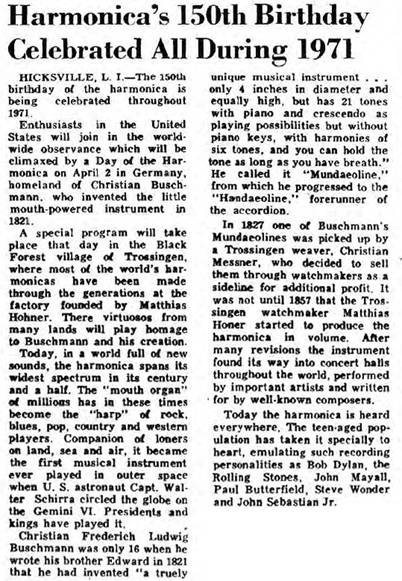
|
|
Troy
,
NY
Record, March 13, 1971
A
footnote: John Sebastian Jr. of the Lovin' Spoonful, who
is mentioned above, is the son of the first man to promote,
arrange, and perform classical music using harmonicas.
|
The growth of watchmaker Hohner's new
business was astounding. For
example, in 1862, only five years after he made his first
"production" harmonica, his company had a distribution branch in the
U.S.
- and it was giving
harmonicas to parents of Civil War soldiers, so that they could send the
pocket-sized instruments to their sons in uniform.
Harmonicas had never been heard in
North America
before the 1860s, and now they would be heard everywhere that soldiers
traveled. In Hicksville and
other places, new immigrants from Europe doubtless brought more
harmonicas to rural
America
. For the next thirty years
and more,
America
's appetite for harmonicas was insatiable: Referenceforbusiness.com
reports that in 1900 alone, Hohner sold almost three million harmonicas to Americans.
|

|
|
Hohner
main headquarters and factories
Trossingen
,
Germany
c. 1920
theharmonicacompany.com
|
Global demand was similarly high; by
the late 1930s, the company employed five thousand workers.
U.S.
Operations
The Hohner family long retained both ownership and management of the
business, control passing from father to son(s).
For its international subsidiaries, control usually was delegated
to brothers, sons, or nephews. As
with a nation, when a corporation is ruled by a "royal family," the
capabilities and imagination of the people in charge may fluctuate
significantly.
The
U.S.
distributor, M. Hohner, Inc.,
originally was headquartered in
Manhattan
. It did not manufacture
instruments, but it imported and warehoused them, supplied them to
dealers, advertised them (via print ads, and also by sponsoring public
events and harmonica competitions), and it maintained connections with
community organizations that might link the business to customers,
especially scouting. For a
while, it also sponsored a weekly network radio broadcast of a harmonica
band.
Harmonicas were affordable and portable.
Hohner's advertising told young men that harmonica playing
would enhance their love life. Adolescents
and boys were told that being able to play would make them the life of
any party - nothing was said, however, about what to do when you
turned up at a party and found that another boy (or perhaps even everyone at the party) had brought along a harmonica.
|
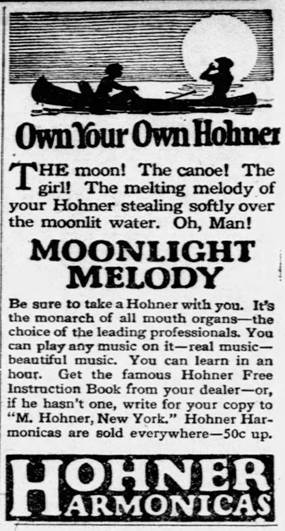
|
|
New
York
Daily News, June 5, 1923
|
|

|
|
New
York
Daily News, December 5, 1937
|
|
*
|
As Nazi Germany prepared for World War II, it
redirected some of Hohner's production line to manufacture detonators
for ordnance - but curiously, the company was permitted to continue
the make harmonicas, albeit at a reduced rate.
Obviously, the war interrupted the flow of Hohner's instruments
into most countries.
After the war, with
Germany
divided, the Trossingen plant benefited from being in
West Germany
. It had relatively few
difficulties increasing production, but the recent war made overseas
sales awkward in nations that had fought against the Axis.
American news media were reluctant to carry advertisements for
West German products; they thought that American consumers needed time
to buy into the idea that West Germans now were allies of the
U.S.
in the Cold War. Although
Hohner resumed selling harmonicas to professional American musicians, it
waited until late 1964 before it felt the country was ready for a new
consumer advertising campaign.
The lack of post-war advertising makes it difficult to confirm just when
M. Hohner, Inc. left
New York City
for
Hicksville
; I have seen the year given in different sources as 1958 and as 1960.
Why did it relocate? Hohner's
business profile at Encyclopedia.com
indicates that the move was made simply because "cost of doing
business [there] was much lower."
An unspoken secondary factor may have been that the ranking Mr.
Hohner of early 1950s lived in
Oyster Bay
.
The
Hicksville
Era Begins, and So Does the Ride Downhill
During its years in
Hicksville
, the parent Hohner company would undergo great changes.
The retail market for musical instruments - the backbone of
Hohner's profits - changed drastically during this era.
From the perspective of Hohner's retail market, the 1950s were the
harmonica's heyday. Many
of the most popular blues and jazz performers used harmonicas.
Their pop counterparts were regularly booked into chic urban
nightclubs, and frequently appeared on television variety shows.
They sold stereo LP albums, and their singles could be heard on
Top 40 AM radio. The theme
from the movie Ruby Gentry*
- orchestral, but with prominent solo harmonica work - had three
different versions on the charts at once in the
U.S.
, and simultaneously was a hit in Europe,
Australia
, and
Canada
. Clearly, the world loved
the plaintive sound of a well-played harmonica.
*Readers
may recall Ray Charles's later vocal recording of the theme, called
simply "Ruby," which was released as a single in November 1960.
By the end of the 1980s, pop's dominance had been
replaced by that of rock. Whatever
music young people listened to, whether Blondie,
the Knack, ABBA, or the Village
People, it did not inspire them to learn to play harmonicas or
accordions. They were buying
electric guitars, amps, drums, and keyboards.
Hohner's feeble but costly efforts to diversify into the
low-end portions of the latter markets had left it with colossal debt.
It's performance in the U.S. led M.
Hohner, Inc. to take an unprecedented step - it passed its
corporate baton to an executive who had no connection to the Hohner
family.
Let's look at what happened during the years when the Hicksville arm
of Hohner tried to ride the ups and downs of America's changing music
scene.
As the 1960s began, Hohner concentrated on
rebuilding its traditional rapport with America, not advertising to the
public at large, but engaging with it in other ways.
This item appeared in the Penn-Yan, NY Chronicle
Express on May 4, 1961 (at a time when much of America was listening
to "Travelin' Man" and "Mother-in-law"):
The Accordion Symphony of the Kenneth Miller Music Studios... will be
presented as part of the fifth annual concert and Variety Show of the
Miller Studios. Playing a
new selection, "Bagatelle," the music for which was imported
from Germany through M. Hohner, Inc., the symphony will make full use of
the unique electric bass accordion and special arranging.
Thanks largely to the publicity people on Andrews Road, Hohner was much
in the public eye by 1964. At
the New York World's Fair, it exhibited in the German Pavilion, where
visitors received tiny souvenir four-hole harmonicas in special boxes.
|

|
|
rubylane.com
|
Newsday, meanwhile, reported that the rise of folk music
was increasing the popularity of Hohner's harmonicas.
|

|
|
Two
excerpts from "Harmonica Sales Aided by Hootenanny Fad"
Newsday,
April 27, 1964
|
"Little Stevie" Wonder sang and played his harmonica up the charts.
His popularity first earned him a part in Muscle
Beach Party, and then one in Bikini
Beach. The
latter's New York premiere was held at
Manhattan's RKO Palace, where Hohner gave harmonicas to the first
five hundred attendees.
|
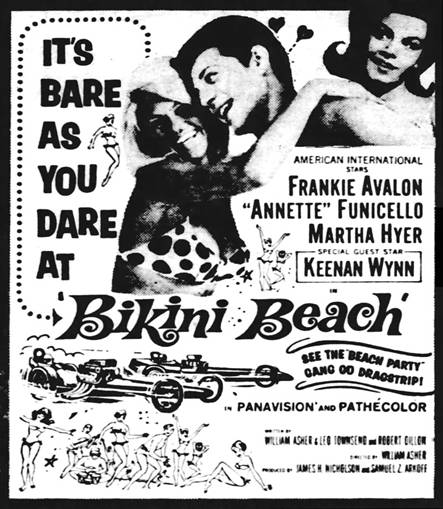
|
|

|
|
New
York Daily News, September 19, 1964
|
|
*
|
Around
the same time, a baseball story put harmonicas into the nation's
sports headlines.
No, that is not a typo. After
appearing to be on their way to the 1964 World Series, the Yankees fell into a late-season slump, and manager Yogi Berra was
fretting. On the team bus
from Comiskey Park after yet another loss to the White
Sox, all was deadly quiet. Phil
Linz, a reserve infielder, took out a harmonica and began to play.
Berra yelled at him to stop; Linz didn't stop.
Berra confronted Linz, who disgustedly flung the harmonica at
Berra - who angrily swatted it away, and into the eye of his first
baseman. For a few days,
sportswriters and fans talked of nothing else; news of the fine that the
club afterwards levied on Linz only stoked the flames.
A few days later, the Yankees and Mets played
their annual charity game at Shea Stadium.
|
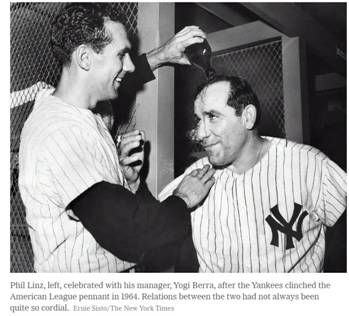
|
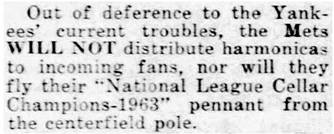
|
|
Phil
Linz, Yogi Berra
New
York Daily News, August 22,1964
|
New
York Daily News, August 24,1964
New York Daily News, August 25,1964
|
|
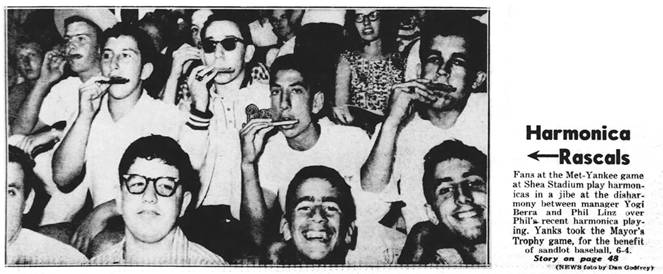
|
Many fans brought along harmonicas, a couple of
which were tossed in the general direction of Berra, but everybody
laughed. Some time later, M. Hohner, Inc. announced that it had signed Linz to contract to
publicize Hohner harmonicas, noting that harmonica sales had climbed
sharply because of the incident.
Searching for a Viable Strategy
In October, advertising firm Smith & Dorian announced that it had agreed to work with M.
Hohner, Inc. on Hohner's first advertising campaign to target the
American consumer in forty years (i.e., since Hitler had first come to
power). The New
York Times of October 20th reported that the company was
again reaching out to children as the primary American market for its
harmonicas, and specifically to scouting.
The words quoted in the following excerpt are from Smith
& Dorian executive Mort Wimpie:
The ads... put the accent on
youth, and will appear in youth-directed publications, such as Jack and
Jill, Junior Scholastic, and Boys' Life.
The basic intention is to re-establish the instrument as part of
the cultural pattern of the country....
This will be in terms of the interest of youth in folk, country
and Western music - and even rock 'n' roll to some degree.
Note that the truly remarkable object of the
campaign was to stem the tide of cultural change - to
"re-establish" a disappearing cultural pattern - through the pages
of Jack and Jill, Junior
Scholastic, and Boys' Life.
One wonders if the word "unrealistic" occurred to anyone at
the time. Regardless,
readers of Boys' Life soon
saw this full page ad, which told people to write to Hohner's
Hicksville address if they wanted to learn more:
|
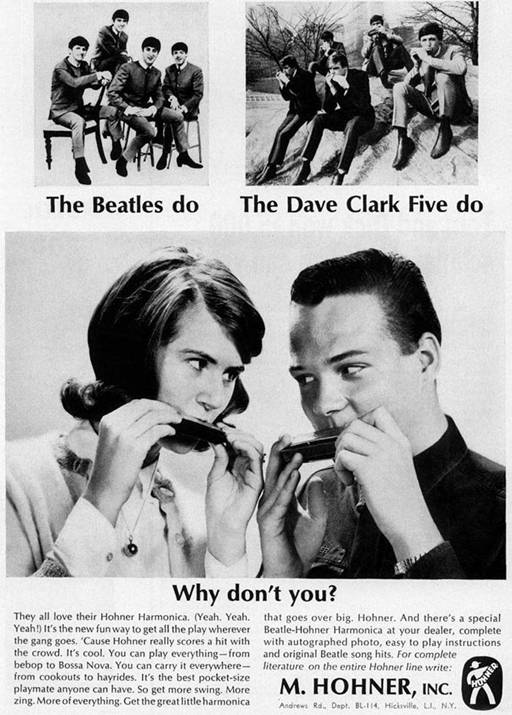
|
|
Boys'
Life, November 1964
|
Another advertisement of this series featured Brian
Jones.
Things were changing swiftly at Hohner.
Less than two years later, a different advertising agency was
launching another campaign, targeting not children and teens but their
parents, who read Life
magazine and the Sunday New York
Times Magazine. It featured not only harmonicas, but Hohner's
newly expanded product line. The
venerable company, which over the course of one hundred and fifty years
had amassed incomparable expertise with harmonicas and accordions, now
was putting its logo on drums, keyboards (both electric and
mouth-blown), and guitars (both acoustic and electric), about which as a
corporation it knew comparatively little.
One imagines the difficulties which the changes
inflicted on the entire business. Hicksville,
like the rest of Hohner, now had to deal with marketing, shipments,
inventory, sales, and repairs of completely different products.
Teething pains were inevitable.
It was reported that when Hohner introduced a new Beatles
guitar model, which bore pictures and names of the Fab
Four, two of the four names were accidentally switched, and thus
appeared on the guitar matched with the wrong Beatle's pictures!
The diversification of the business meant that many people were
inexperienced in their jobs - either the jobs themselves were new, or
the people in them had been transferred from elsewhere in Hohner, or the
people were new hires. Some
of the traditional harmonica expertise got dispersed around the company,
weakening expertise for the company's core product.
|
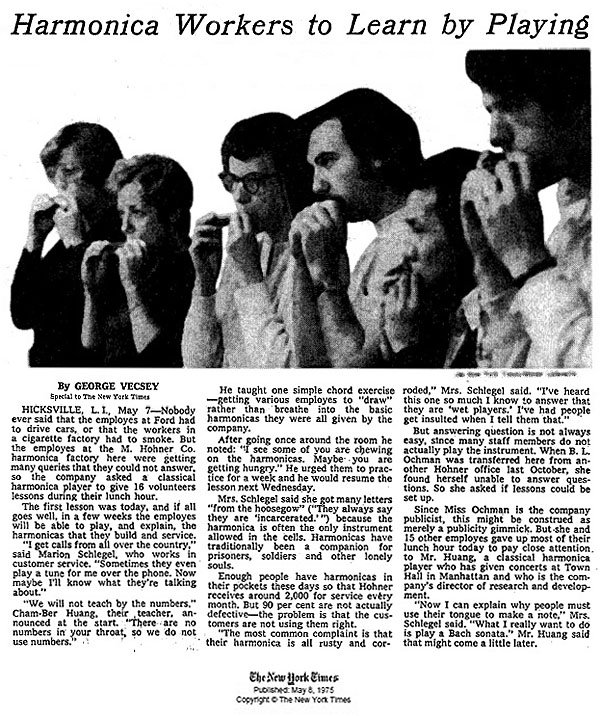
|
|
***
|
And Some "Harmonica People"
Soldiered On
|
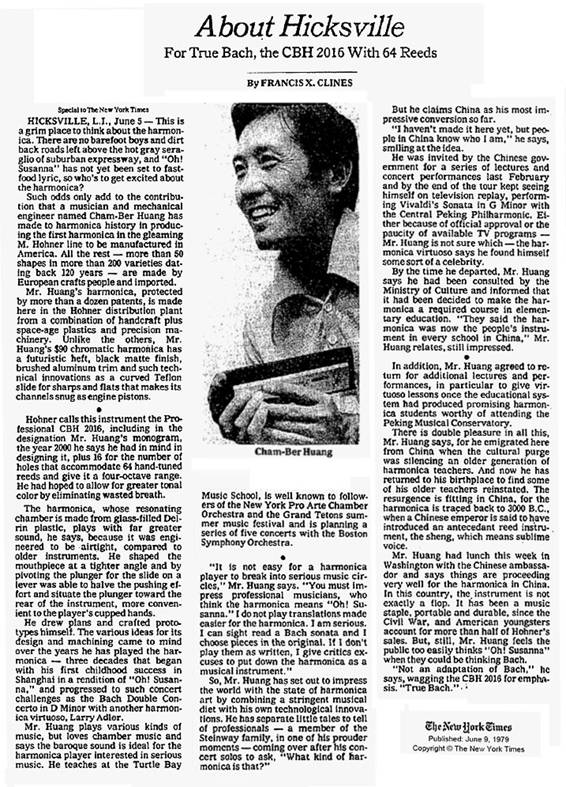
|
|
It's clear from the opening paragraph that the Times reporter was not thrilled to drive to Hicksville via the
L.I.E. on a hot day in 1975, go south on Broadway, and then head
down Bethpage Road to Andrews.
Obviously, he had hoped to see lots of picturesque grass
and trees, but instead he got more than his fill of suburbia,
with its abundant pavement and fast-food signs.
|
|
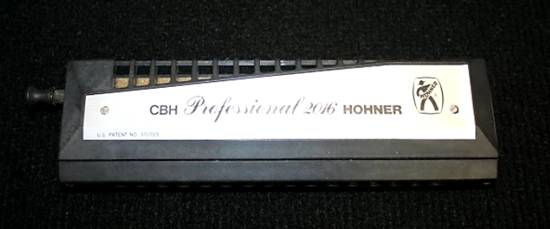
|
|
Hohner
CBH 2016
reverb.com/uk
This
was the first Hohner harmonica ever designed
and manufactured anywhere other than Europe.
A
few years later, another model, also designed by
Mr. Huang, would follow.
|
|
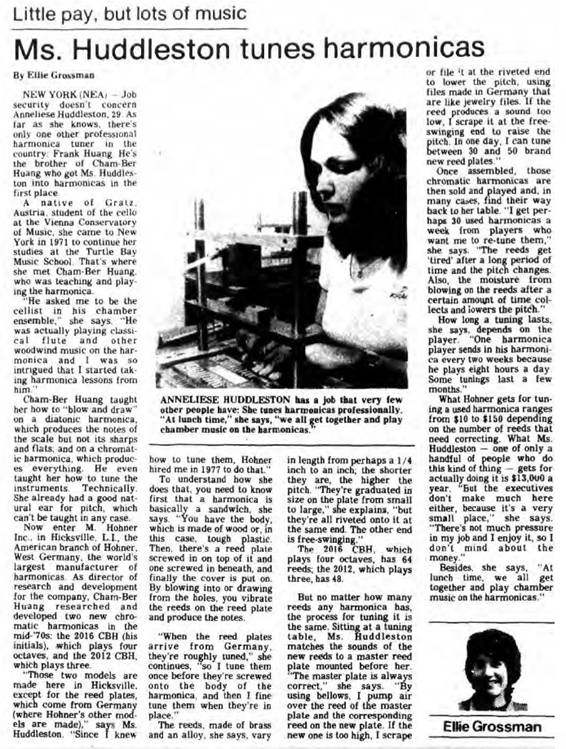
|
|
Medina,
NY Journal Register, March 3, 1982
|
|
***
|
End of the (Andrews) Road
By the early 1980s, all of Hohner was in crisis.
It had not made inroads into the new mainstream guitar / drum /
keyboard / amp market, and there was no way that selling cheap
harmonicas to Cub Scouts would ever pay off its debt.
Every day Hohner sank further into the red.
M. Hohner, Inc. was put into
the hands of an American executive, who tried to plug whatever leaks he
could. By 1983, he had moved
the U.S. operation to Richmond, Virginia, where labor costs were
cheaper, as were the costs associated with importing shipments from
Europe. He ultimately left
and was replaced, not that it mattered very much - the cash flow of
the parent corporation mattered far more.
By the 1990s, all of Hohner was acquired by a private investor, who in
turn sold it to a conglomerate. It
had the resources to pay off all of Hohner's debts.
It then transferred production of the inexpensive harmonicas
models, especially those meant for children, to Taiwan, which permitted
the German operation to downsize, and focus on high-quality instruments
for professionals. The new,
smaller Hohner concentrated on making harmonicas and accordions, as the
old Hohner had, and it became profitable.
Although the Hicksville part of the story is all but forgotten,
Hohner survives.
My Own and Final Word
This is my last Ancient
Hixtory article for Hixnews - I need a break.
Over the last forty-eight months, I've written about 125,000 words of
prose from scratch, and I've tracked down thousands of images
(although I've used only about five hundred of them).
In total, I've spent about fifty work-weeks doing research, and
more than that editing digital pictures and writing.
By leaving behind that level of activity, I hope to have more
time for my family, for the demands my century-old house, and maybe even
to travel some more.
I have my regrets about leaving, including not
having written about several topics I wanted to cover.
They are, however, subjects which could not adequately be
researched online, and the pandemic kept me from crossing the border
from Canada to visit archives in the New York area.
Oh well.
I want to thank those of you who have given me feedback on these
articles. I especially want
to thank both Buffalo Bob Casale (editor) and Roger Whitaker (webmaster)
at Hixnews.com. Their hard
work and patience have made my monthly involvement a pleasure.
I wish them continued good fortune, and I hope that new (and
younger) energy is offered to them, to keep Hixnews going strong in the
future.
Ciao,
Ron Wencer
|



















